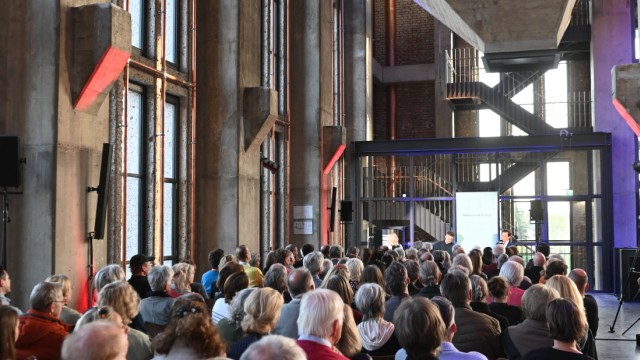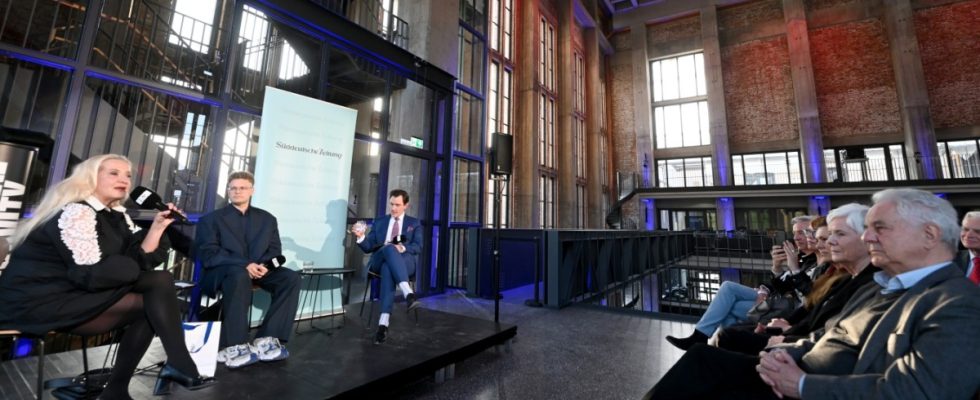It’s not possible at the Bergson without temporary use either, that’s just how it is in Munich. Here, every empty space is immediately used for something else, as a pop-up club, yoga quarters or makeshift dirndl boutique. The Bergson artificial power plant in the west of the city, which opened just a few days ago, is fortunately spared from this, but there are still temporary users: a pair of kestrels lives under the roof, pug bats flutter through the warm, damp basement – but only in winter, in summer the animals go out into the surrounding forests. “Living beings that were there before us are allowed to stay,” said Roman Sladek on Thursday evening at the Kultursalon South German newspapera habitat was even built specifically for the intermediate users in the basement who are at great risk.
The trained trombonist Sladek is the founder of the Jazz Rush Big Band and artistic director at Bergson. Or as he himself says: “I am the court jester.” In the old-fashioned way, you could also say “intendent,” he adds. It is a relaxed and humorous conversation that the head of the SZ culture department for Munich and Bavaria, Susanne Hermanski, moderated on Thursday evening in the gallery of this 25 meter high cultural cathedral. Outside the sun is setting and flooding the former boiler hall with light once again, inside all the seats are occupied: Curiosity about this “miracle in pretty dreary times” (as the presenter calls it) is quite high.
You can also see this in the atrium, which continues to fill up as the evening progresses. Sitting upstairs next to Roman Sladek is Maximilian Maier, he is the program curator at the Bergson, his official title is “Director of Programming and Public Relations”. Unofficially, he describes himself as a “dramaturg”. But it’s not so much about job titles and hierarchies; they came together as a team, assures Maier. “It’s a Siamese love between the two of us.”
Visually, the two mid-thirties couldn’t be more different, but that’s the case with many artist-curator lovers, whether Siamese or not. The reason why these men appear so relaxed (in fine leather shoes or chunky ugly sneakers), why they can make jokes and tease each other, also has something to do with organizational forms: The Bergson is financed purely by the private sector, the artistic directors have to This means that they cannot justify themselves before committees, committees or public concerns. Their bosses are the entrepreneurial brothers Michael and Christian Amberger, who own the Allguth gas station chain – and since 2005 also the former Aubinger thermal power plant, which they have transformed into a modern art, culture and culinary temple over years of renovation work.
The guests marvel at the architecture with the enormously high ceilings, as do actor Götz Otto and his wife Sabine.
(Photo: Stephan Rumpf)
This evening is of course also about the history of this building; it goes back to the 1920s. At that time, an unknown architect drew up the plans for a thermal power plant – where it would be built was not yet clear at the time. The construction project began to move at the end of the 1930s when the National Socialists wanted to move Munich Central Station to the west and needed a building for the energy supply. Construction work began in 1940 and ended two years later due to the war. So this project was never finished; it was originally supposed to be much bigger.
Deutsche Bahn used it as a heating plant from 1955, but it was shut down in the 1980s. The building fell into disrepair, techno parties, underground shootings and other not entirely legal events took place. When the new owners bought it, the huge hall was probably in a pitiful condition. But they didn’t want to turn it into a Munich Berghain, despite the similarity in name to the famous Berlin techno club (which is also located in a disused heating plant). The Bergson in Aubing takes its name from the nearby Bergsonstrasse, which in turn refers to the French philosopher and Nobel Prize winner Henri-Louis Bergson.

When the new owners bought it, the huge hall was probably in a pitiful condition. Now it is an impressive cultural site.
(Photo: Stephan Rumpf)
“The coal silos are above us,” explains Sladek during the stage discussion. Dozens of pairs of eyes then wander up to admire the monumental funnels. There are some references to the original use of the hall; Sladek and Maier want to integrate them in a playful way. A gallery is set to move into the silos from May onwards; the Bavarian State Orchestra’s first concert with Sergei Prokofiev’s “Peter and the Wolf” took place in the atrium a few days ago. There is a bar and a restaurant that is also already welcoming guests.
Otherwise, a lot is still being developed, Maier explains in an interview: the new building next door will open in June, then private or company events can also take place in the Bergson, there will be a large gallery area and a beer garden. A separate place for concerts or readings is also being created; it is named after the interim users in the basement: The Mopsbat alias Barbastella barbastellus is the namesake for the live club “Barbastelle” in the basement of the Bergson.
The Bergson plans are likely to be a topic of conversation
And then there is the 476-seat concert hall, which is scheduled to open in October. A new concert hall? In Munich? Of course, the guests (including the former Bavarian Finance Minister Kurt Faltlhauser, the art manager and presenter Judith Milberg, the film producer Philipp Kreuzer and the actor Götz Otto) listen more closely. This has not only been a political issue since the “pause for thought” surrounding the concert hall in the Werksviertel, the general renovation of the Gasteig and the State Opera in need of renovation.
The Bergson plans are likely to be a topic of conversation, and they also lead Sladek to make what is probably the most provocative statement of the evening: “As a professional musician, I don’t hear any difference.” What is meant is the concert hall’s innovative spatial and acoustic concept: There are very few people left who only listen to classical music, he says, so the hall is being designed for a wide variety of types of music thanks to electronically amplified acoustics. Among other things, also for his Jazz Rush Big Bandwho travels a lot, who performs in the Hamburg Elbphilharmonie as well as in the Nuremberg State Theater and at Elmau Castle – and who, as the “Orchestra in Residence”, is the Bergson’s house band.

After the discussion, the guests, such as Prince Wilhelm Ernst of Saxony Weimar (left) and Bergson architect Markus Stenger, met for a casual conversation.
(Photo: Stephan Rumpf)

Also in conversation: Thomas Greinwald and Angelika Nollert, head of the New Collection in Munich.
(Photo: Stephan Rumpf)
“It’s like a perfect recording studio, only in a hall,” Sladek continues. The sound is absorbed differently, you can even change the room acoustics from piece to piece, simply by pressing a button. It remains to be seen whether he can score points with classical music purists – and whether they might want to hear a difference, too. A separate production is planned for the opening in autumn, which will make the acoustic characteristics of the room tangible.
The expectations are high, not just among the guests of the SZ-Kultursalon, but one thing is still on Maximilian Maier’s heart: “We don’t want to get involved in the concert hall discussion.” They will prove that the offer in the new concert hall meets demand. In a one-on-one conversation later in the evening, he will also talk about the planned Bergson Academy, which aims to promote public dialogue about current topics. Starting in June, there will be a series of lectures on the Middle East, with experts such as the historian and journalist Michael Wolffsohn, the journalist Natalie Amiri and the Bavarian Interior Minister Joachim Herrmann.
With so many ambitious plans and in view of the high-quality renovated rooms, the question still arises as to the investment volume. Maier answered this very briefly on stage: “No, I don’t know.” His partner Sladek suggests that he perhaps knows a little more, but is not allowed to say this publicly. That is also the advantage of this privately operated cultural temple, this miracle in dreary times. Here, a not-so-small team of mostly young people sets out to create something new. Of course, Maier admits that this is a big challenge, also economically, you will have to have patience and perseverance. This is also what we want from the operators; it is an investment that will probably only pay off in the long term.
On the way back to the nearby Langwied S-Bahn station, you walk past gray bridges and concrete walls, one of which reads: “All the best, you pig.” It doesn’t quite fit with the animal inhabitants of this art power plant, but you still want to join in with this congratulation.

